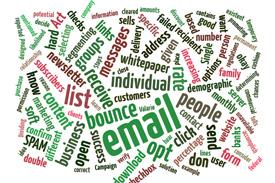9 Email Marketing Terms You Should Know
As email marketing becomes a more integral part of doing business online, it’s important to know the basic information that can help you succeed at it. Here are nine email marketing terms you should have memorized.
1. CAN-SPAM Act - The CAN-SPAM Act of 2003 made it a federal crime for a business or person to send commercial email messages to individuals who have not given specific permission to that business or person to contact them. To learn more about the CAN-SPAM Act and its regulations, check out Valarie’s post on knowing when it’s okay to email people.
2. Opt-in - When an individual tells you that it’s okay to put them on your newsletter or email list, they are “opting-in.” The most common form of opting-in is selecting a checkbox on a website, such as the one at the bottom of the download form for our whitepaper, 9 Smart Steps to Success with PPC. Only after an individual checks the “Send me the monthly newsletter” option will we place them on a list to receive our monthly newsletter.
3. Single and Double Opt-in - The two different opt-in options. If you set your email marketing solution to Single opt-in, all a user has to do is select the checkbox I mentioned above, submit the form, and they’re on the list. In a double opt-in, a user will receive an email asking them to confirm their wish to receive emails; if they don’t confirm, they will not be added to the list.
4. Segmenting - Dividing potential buyers into smaller groups based on buying patterns or demographic information. For example, you may have a flooring company that sells to two different groups, such as big banks and small families. Your bank customers don’t want to hear that this kind of carpet cushion’s a baby’s fall; and your family customers don’t care that the tile you sell is professional and can be bought for discount in amounts of 10,000 square feet or more. By segmenting your email list along demographic lines, you can produce content that is more specific to each group, increasing the likelihood that both groups will bring you business.
5. Campaign - An email marketing message or series of messages designed to accomplish an overall goal — such as promoting a sale, increasing your business by 10%, or getting people to download a whitepaper or ebook.
6. Soft bounce - When you send out an email to your list, chances are good that there will be some bounces, and some people will not receive your email. A soft bounce is the failed delivery of an email due to a temporary issue, like a full mailbox or an unavailable server. If you have a high soft bounce rate, try waiting a little while and emailing just those addresses again, as the server might be fixed, or an individual might have cleared their inbox.
7. Hard bounce - On the other hand, a hard bounce is the failed delivery of an email due to a permanent reason like a non-existent address. If you have a close enough relationship with the members of your list, consider calling those whose emails had a hard bounce and verify that the email address you were given is correct. If you do not have a way to contact people individually, it may be best to remove them from your system so that your list contains only those people who you know are receiving your emails.
8. Open rate - The number of recipients (as a percentage) who open any given email you send. This metric is helpful in determining an email’s success, but it can also trick you: open rates may be under- or over-reported based on which email clients your subscribers use. In other words, don’t rely solely on an email’s open rate to decide whether or not it was successful.
9. Click-through rate (CTR) - The number of recipients (as a percentage) who click a link or links within your email message. Knowing how many people clicked on the links in your email gives you a good idea of what content is most popular, and what content you can leave out next time. The more you focus on the content that your subscribers want, the more likely they’ll be to click through to your website and join, download a whitepaper, make a purchase, etc.
This is, of course, a non-exhaustive list. Which terms would you add?
Related Posts
MONTHLY MARKETING INSIGHTS.
Get thought-provoking and actionable insights to improve how your firm makes a connection with your customers.





LEAVE A COMMENT
How about "Unsubscribe?"
Even if you follow all the rules regarding permission, people are fickle and may easily decide your message is unwanted. Always give an option to opt-out of your messaging. You don't want to tarnish you brand by becoming a spammer in their eyes.
True, and that is something that is covered under the umbrella of the CAN-SPAM Act (although it's definitely worth a separate mention).